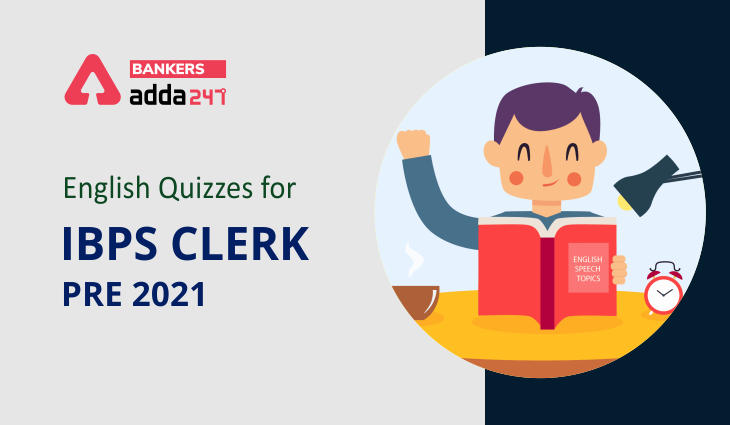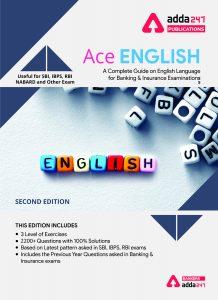 Directions (1-5): Given below are six sentence (A), (B), (C), (D), (E) and (F) which may not be in the logical sequence. Rearrange the sentences to form a meaningful paragraph and answer the questions that follows.
Directions (1-5): Given below are six sentence (A), (B), (C), (D), (E) and (F) which may not be in the logical sequence. Rearrange the sentences to form a meaningful paragraph and answer the questions that follows.
(A) “The seat-sharing arrangement with the BJP is in the final and last stage… It will be announced soon,” JD(U) Rajya Sabha member R.C.P. Singh told journalists after a four-hour State executive meeting on Sunday.
(B) JD(U) sources said the BJP had assured the party of 15 of the 40 seats. The other NDA allies, Rashtriya Lok Samata Party (RLSP) and Lok Janshakti Party (LJP), have been demanding early finalization of seat-sharing.
(C) Leaders of the ruling Janata Dal (United) in Bihar said seat-sharing talks for the 2019 Lok Sabha poll with the BJP were in the last stage, and a deal would be announced soon.
(D) Mr. Singh is considered close to JD(U) president and Bihar Chief Minister Nitish Kumar. “The JD(U) will priority to the youth in ticket distribution,” he added.
(E) He said workers would be trained from the booth level.
(F) Mr. Singh said the executive discussed how to strengthen and expand the organization.
Q1. Which among the following is the FISRT sentence of the rearranged paragraph?
(a) A
(b) B
(c) C
(d) E
(e) D
Q2. Which among the following is the SECOND sentence of the rearranged paragraph?
(a) A
(b) B
(c) C
(d) E
(e) D
Q3. Which among the following is the FIFTH sentence of the rearranged paragraph?
(a) A
(b) B
(c) C
(d) F
(e) D
Q4. Which among the following is the FOURTH sentence of the rearranged paragraph?
(a) A
(b) B
(c) C
(d) E
(e) D
Q5. Which among the following is the SIXTH sentence of the rearranged paragraph?
(a) A
(b) B
(c) C
(d) E
(e) D
Directions (6-10): Given below is a paragraph with few words being omitted against each number. Each number is given below along with five alternatives. Choose the most suitable alternative among the given five that DOES NOT fill the blank to form a grammatically correct and contextually meaningful paragraph.
Q6. The decriminalisation of homosexuality in the Navtej Johar judgment holds special relevance for transgender rights. Not only was Section 377 used (6) _______________________ against transgender persons, the (7) _______________________ battle also took a new and positive turn from 2014 after the Supreme Court recognised the right to gender identity in NALSA v. Union of India. Therefore, it is only (8) _______________________ that we (9) _______________________ some attention to the contributions of the trans community to this outcome and (10) _______________________ how the judgment takes transgender rights forward.
(a) disproportionately
(b) nearly
(c) excessively
(d) unduly
(e) superfluously
Q7. The decriminalisation of homosexuality in the Navtej Johar judgment holds special relevance for transgender rights. Not only was Section 377 used (6) _______________________ against transgender persons, the (7) _______________________ battle also took a new and positive turn from 2014 after the Supreme Court recognised the right to gender identity in NALSA v. Union of India. Therefore, it is only (8) _______________________ that we (9) _______________________ some attention to the contributions of the trans community to this outcome and (10) _______________________ how the judgment takes transgender rights forward.
(a) incessant
(b) legal
(c) juridical
(d) lawful
(e) constitutional
Q8. The decriminalisation of homosexuality in the Navtej Johar judgment holds special relevance for transgender rights. Not only was Section 377 used (6) _______________________ against transgender persons, the (7) _______________________ battle also took a new and positive turn from 2014 after the Supreme Court recognised the right to gender identity in NALSA v. Union of India. Therefore, it is only (8) _______________________ that we (9) _______________________ some attention to the contributions of the trans community to this outcome and (10) _______________________ how the judgment takes transgender rights forward.
(a) fitting
(b) inadequate
(c) apt
(d) felicitous
(e) proper
Q9. The decriminalisation of homosexuality in the Navtej Johar judgment holds special relevance for transgender rights. Not only was Section 377 used (6) _______________________ against transgender persons, the (7) _______________________ battle also took a new and positive turn from 2014 after the Supreme Court recognised the right to gender identity in NALSA v. Union of India. Therefore, it is only (8) _______________________ that we (9) _______________________ some attention to the contributions of the trans community to this outcome and (10) _______________________ how the judgment takes transgender rights forward.
(a) bestow
(b) grant
(c) provide
(d) impart
(e) flays
Q10. The decriminalisation of homosexuality in the Navtej Johar judgment holds special relevance for transgender rights. Not only was Section 377 used (6) _______________________ against transgender persons, the (7) _______________________ battle also took a new and positive turn from 2014 after the Supreme Court recognised the right to gender identity in NALSA v. Union of India. Therefore, it is only (8) _______________________ that we (9) _______________________ some attention to the contributions of the trans community to this outcome and (10) _______________________ how the judgment takes transgender rights forward.
(a) inspect
(b) study
(c) analyze
(d) zap
(e) examine
Directions (11-15): In the following questions, a sentence is given with an idiom/ phrase given in bold which may or may not be correct. Choose the most suitable alternative among the four that may replace the incorrect idiom in the sentence. If the given idiom is correct, then choose option (e) i.e. “no replacement required” as your answer choice.
Q11. Chotu, an office boy, was dismissed from the employment as the senior management received complaints against him about eating a humble pie in the office.
(a) biting the bullet
(b) giving himself air
(c) bringing to light
(d) bone of contention
(e) No replacement required
Q12. Though, last year barking is worse than bite at the National Games, Suresh continued his perspiration in the training camp for wrestling and finally made the golden knock, winning the Gold Medal at the Asian Games.
(a) ended up in smoke
(b) drove home
(c) made the left-handed compliment
(d) taken his coach to task
(e) No replacement required
Q13. Fearing ill at ease, the new office boy in the company greets everyone in the morning, noon and at evening.
(a) beating about the bush
(b) maiden speech
(c) cutting a sorry figure
(d) on tenterhooks
(e) No replacement required
Q14. Receiving the news of the death of his girlfriend on a call has made Tanmay to start beating about the bush.
(a) beside the mark
(b) face the music
(c) call in question
(d) throwing caution to the winds
(e) No correction required
Q15. Kumar Vishwash appeared like weal and woe in Indian Politics when he contested elections against Rahul Gandhi in Amethi in 2014.
(a) pick to pieces
(b) a cuckoo in the nest
(c) draw a blank
(d) a drop in the bucket
(e) No correction required
Solutions
S1. Ans. (c)
Sol. The final sequence is CADBFE.
(C) provides the introduction for the paragraph ‘seat-sharing talks between the BJP and the JD (U)’. Hence, it should be the first sentence of the coherent paragraph.
(A) introduces a JD (U) leader Mr. R.C.P. Singh which the statements (D), (E) and (F), which mention or refer to Mr. Singh, don’t. So, (A) must precede the statements (D), (E) and (F).
Now, among (A) and (B), which one should be the second sentence of the paragraph?
The statement (A) quotes the leader who reiterates the theme of the paragraph “The seat-sharing arrangement with the BJP is in the final and last stage…” So, (A) qualifies (C) better than (B). So, (A) should be the second sentence.
Which one should be the third sentence? The statement (D) qualifies Mr. Singh, and so, it should immediately follow (A) because (A) introduces R.C.P. Singh. So, (D) should be the THIRD sentence.
Hence, we get the sub-sequence CAD.
The statement F starts with ‘Mr. Singh’, while the statement (E) starts with a pronoun ‘He’. A pronoun usually appears only after its antecedent is introduced. The statement (F) introduces Mr. Singh while the statement (E) uses the pronoun ‘he’.
Now, thinks, what would be the need to re-introduce Mr. Singh when he is already introduced and appears till the statement D?
Such need would only arise only when a sentence introduces something completely different aspect to the paragraph without mentioning and/or referring to Mr. Singh. That sentence is (B).
So, (B) should be the Fourth sentence. After the appearance of (B) as the fourth sentence, there would be a need to re-introduce Mr. Singh to convey the additional information conveyed by Mr. Singh.
Now, among (F) and (E), we have already decided why (F) should be the FIFTH sentence (because, it re-introduces Mr. Singh).
Now, (E) must be the LAST sentence.
Hence, the final sequence is CADBFE. Therefore, option (c) is the most suitable answer choice.
S2. Ans. (a)
Sol. The final sequence is CADBFE.
(C) provides the introduction for the paragraph ‘seat-sharing talks between the BJP and the JD (U)’. Hence, it should be the first sentence of the coherent paragraph.
(A) introduces a JD (U) leader Mr. R.C.P. Singh which the statements (D), (E) and (F), which mention or refer to Mr. Singh, don’t. So, (A) must precede the statements (D), (E) and (F).
Now, among (A) and (B), which one should be the second sentence of the paragraph?
The statement (A) quotes the leader who reiterates the theme of the paragraph “The seat-sharing arrangement with the BJP is in the final and last stage…” So, (A) qualifies (C) better than (B). So, (A) should be the second sentence.
Which one should be the third sentence? The statement (D) qualifies Mr. Singh, and so, it should immediately follow (A) because (A) introduces R.C.P. Singh. So, (D) should be the THIRD sentence.
Hence, we get the sub-sequence CAD.
The statement F starts with ‘Mr. Singh’, while the statement (E) starts with a pronoun ‘He’. A pronoun usually appears only after its antecedent is introduced. The statement (F) introduces Mr. Singh while the statement (E) uses the pronoun ‘he’.
Now, thinks, what would be the need to re-introduce Mr. Singh when he is already introduced and appears till the statement D?
Such need would only arise only when a sentence introduces something completely different aspect to the paragraph without mentioning and/or referring to Mr. Singh. That sentence is (B).
So, (B) should be the Fourth sentence. After the appearance of (B) as the fourth sentence, there would be a need to re-introduce Mr. Singh to convey the additional information conveyed by Mr. Singh.
Now, among (F) and (E), we have already decided why (F) should be the FIFTH sentence (because, it re-introduces Mr. Singh).
Now, (E) must be the LAST sentence.
Hence, the final sequence is CADBFE. Therefore, option (a) is the most suitable answer choice.
S3. Ans. (d)
Sol. The final sequence is CADBFE.
(C) provides the introduction for the paragraph ‘seat-sharing talks between the BJP and the JD (U)’. Hence, it should be the first sentence of the coherent paragraph.
(A) introduces a JD (U) leader Mr. R.C.P. Singh which the statements (D), (E) and (F), which mention or refer to Mr. Singh, don’t. So, (A) must precede the statements (D), (E) and (F).
Now, among (A) and (B), which one should be the second sentence of the paragraph?
The statement (A) quotes the leader who reiterates the theme of the paragraph “The seat-sharing arrangement with the BJP is in the final and last stage…” So, (A) qualifies (C) better than (B). So, (A) should be the second sentence.
Which one should be the third sentence? The statement (D) qualifies Mr. Singh, and so, it should immediately follow (A) because (A) introduces R.C.P. Singh. So, (D) should be the THIRD sentence.
Hence, we get the sub-sequence CAD.
The statement F starts with ‘Mr. Singh’, while the statement (E) starts with a pronoun ‘He’. A pronoun usually appears only after its antecedent is introduced. The statement (F) introduces Mr. Singh while the statement (E) uses the pronoun ‘he’.
Now, thinks, what would be the need to re-introduce Mr. Singh when he is already introduced and appears till the statement D?
Such need would only arise only when a sentence introduces something completely different aspect to the paragraph without mentioning and/or referring to Mr. Singh. That sentence is (B).
So, (B) should be the Fourth sentence. After the appearance of (B) as the fourth sentence, there would be a need to re-introduce Mr. Singh to convey the additional information conveyed by Mr. Singh.
Now, among (F) and (E), we have already decided why (F) should be the FIFTH sentence (because, it re-introduces Mr. Singh).
Now, (E) must be the LAST sentence.
Hence, the final sequence is CADBFE. Therefore, option (d) is the most suitable answer choice.
S4. Ans. (b)
Sol. The final sequence is CADBFE.
(C) provides the introduction for the paragraph ‘seat-sharing talks between the BJP and the JD (U)’. Hence, it should be the first sentence of the coherent paragraph.
(A) introduces a JD (U) leader Mr. R.C.P. Singh which the statements (D), (E) and (F), which mention or refer to Mr. Singh, don’t. So, (A) must precede the statements (D), (E) and (F).
Now, among (A) and (B), which one should be the second sentence of the paragraph?
The statement (A) quotes the leader who reiterates the theme of the paragraph “The seat-sharing arrangement with the BJP is in the final and last stage…” So, (A) qualifies (C) better than (B). So, (A) should be the second sentence.
Which one should be the third sentence? The statement (D) qualifies Mr. Singh, and so, it should immediately follow (A) because (A) introduces R.C.P. Singh. So, (D) should be the THIRD sentence.
Hence, we get the sub-sequence CAD.
The statement F starts with ‘Mr. Singh’, while the statement (E) starts with a pronoun ‘He’. A pronoun usually appears only after its antecedent is introduced. The statement (F) introduces Mr. Singh while the statement (E) uses the pronoun ‘he’.
Now, thinks, what would be the need to re-introduce Mr. Singh when he is already introduced and appears till the statement D?
Such need would only arise only when a sentence introduces something completely different aspect to the paragraph without mentioning and/or referring to Mr. Singh. That sentence is (B).
So, (B) should be the Fourth sentence. After the appearance of (B) as the fourth sentence, there would be a need to re-introduce Mr. Singh to convey the additional information conveyed by Mr. Singh.
Now, among (F) and (E), we have already decided why (F) should be the FIFTH sentence (because, it re-introduces Mr. Singh).
Now, (E) must be the LAST sentence.
Hence, the final sequence is CADBFE. Therefore, option (b) is the most suitable answer choice.
S5. Ans. (d)
Sol. The final sequence is CADBFE.
(C) provides the introduction for the paragraph ‘seat-sharing talks between the BJP and the JD (U)’. Hence, it should be the first sentence of the coherent paragraph.
(A) introduces a JD (U) leader Mr. R.C.P. Singh which the statements (D), (E) and (F), which mention or refer to Mr. Singh, don’t. So, (A) must precede the statements (D), (E) and (F).
Now, among (A) and (B), which one should be the second sentence of the paragraph?
The statement (A) quotes the leader who reiterates the theme of the paragraph “The seat-sharing arrangement with the BJP is in the final and last stage…” So, (A) qualifies (C) better than (B). So, (A) should be the second sentence.
Which one should be the third sentence? The statement (D) qualifies Mr. Singh, and so, it should immediately follow (A) because (A) introduces R.C.P. Singh. So, (D) should be the THIRD sentence.
Hence, we get the sub-sequence CAD.
The statement F starts with ‘Mr. Singh’, while the statement (E) starts with a pronoun ‘He’. A pronoun usually appears only after its antecedent is introduced. The statement (F) introduces Mr. Singh while the statement (E) uses the pronoun ‘he’.
Now, thinks, what would be the need to re-introduce Mr. Singh when he is already introduced and appears till the statement D?
Such need would only arise only when a sentence introduces something completely different aspect to the paragraph without mentioning and/or referring to Mr. Singh. That sentence is (B).
So, (B) should be the Fourth sentence. After the appearance of (B) as the fourth sentence, there would be a need to re-introduce Mr. Singh to convey the additional information conveyed by Mr. Singh.
Now, among (F) and (E), we have already decided why (F) should be the FIFTH sentence (because, it re-introduces Mr. Singh).
Now, (E) must be the LAST sentence.
Hence, the final sequence is CADBFE. Therefore, option (d) is the most suitable answer choice.
S6. Ans. (b)
Sol. The context of the sentence suggests that the provisions of Section 377 were used unnecessarily against transgender person.
Disproportionate [adjective] means ‘too large or too small in comparison to something else, or not deserving its importance or influence’; excessive; unduly;
Superfluously [adverb] means ‘unnecessarily’;
So, options (a), (c), (d) and (e) are synonyms.
So, the options (a), (c), (d) and (e) fulfill the contextual and grammatical requirement imposed on the blank.
The correct part would be ‘Section 377 used disproportionately against transgender persons.’
But the option (b) is completely irrelevant to the context of the sentence.
Hence, option (b) is the correct answer.
S7. Ans. (a)
Sol. The blank would be filled by an adjective which would qualify the noun ‘battle’. The context of the passage suggests that the rights which they are talking about are the legal, constitutional rights of the transgender community.
Options (b), (c), (d) and (e) are sort of synonyms and all satisfy the contextual and grammatical requirements imposed on the blank.
Incessant [adjective] means ‘(of something regarded as unpleasant) continuing without pause or interruption’;
The correct part would be ‘, the legal battle also took a new’.
But the option (a) is completely different and irrelevant.
Hence, the correct answer is option (a).
S8. Ans. (b)
Sol. ‘Fitting’ [adjective] means ‘suitable or right for a particular situation or occasion’;
The context of the sentence suggests that the word which would fill the blank would be ‘suitable or apt’ etc.
Options (a), (c), (d) and (e) are synonyms and all could fill up the blank, satisfying the contextual and grammatical requirement of the blank.
The correct phrase would be ‘it is only fitting’.
But, only, the option (b) is completely irrelevant to the context of the requirements imposed on the blank.
Hence, the correct answer is option (b).
S9. Ans. (e)
Sol. The tone of the sentence suggests that the word which should fill the blank is ‘provide’- ‘we provide some attention to the contributions…’
Bestow [verb] means ‘to give something as an honour or present’;
Grant [verb] means ‘an amount of money given especially by the government to a person or organization for a special purpose’;
Flays [verb] means ‘strip the skin off (a corpse or carcass)’;
Options (a), (b), (c) and (d) are synonyms, and also satisfy the grammatical and contextual requirement of the sentence.
But only option (e) is completely irrelevant to the context of the sentence and is the correct answer.
The correct phrase would be ‘that we bestow some attention’.
S10. Ans. (d)
Sol. The tone of the sentence suggests that the word which would fill the blank is ‘study or examine or etc.’
Zap [verb] means ‘go quickly’;
Options (a), (b), (c) and (e) satisfy the contextual and grammatical requirement of the blank. Also, they, upon filling the blank, make meaningful sentence.
The correct phrase would be ‘examine how the judgment takes transgender rights forward.’
Among the options, only option (d) is completely irrelevant to the context of the blank and is the correct answer.
Hence, option (d) is the correct answer.
S11. Ans. (b)
Sol. The highlighted phrase and the options (a), (b), (c) and (d) are idioms.
‘Eating a humble pie’ means ‘to yield under humiliating circumstances’;
‘Biting the bullet’ means ‘to get something over with because it is inevitable’;
‘Giving himself air’ means ‘behaving arrogantly’;
‘Bringing to light’ means ‘revealing something’;
‘Bone of contention’ means ‘a cause for quarrel’;
Among the above idioms, only the option (b) is the idiom which is relevant and contextually meaningful as the context of the given sentence.
Hence, option (b) is the correct answer.
S12. Ans. (a)
Sol. The highlighted phrase and the options (a), (b), (c) and (d) are idioms.
‘Barking is worse than bite’ means ‘threat is worse than the action taken’;
‘Ended up in smoke’ means ‘to fail’;
‘Drove home’ means ‘to emphasize’;
‘left-handed compliment’ means ‘an ambiguous compliment;
‘To take someone to task’ means ‘to reprimand someone’;
Among the given idioms, only the idiom present in the option (a) is contextually meaningful and relevant to the given sentence and hence, is the correct answer.
S13. Ans. (c)
Sol. The highlighted phrase and the options (a), (b), (c) and (d) are idioms.
‘Ill at ease’ means ‘uneasy’
‘Beating about the bush’ means ‘to talk about irrelevant things’;
‘Maiden speech’ means ‘first speech’;
‘Cut a sorry figure’ means ‘made a poor impression’;
‘On tenterhooks’ means ‘in suspense and anxiety’;
Among the idioms mentioned above, idiom presented in the option (c) correctly satisfy the contextual requirement of the given sentence.
Hence, option (c) is the correct answer.
S14. Ans. (d)
Sol. The highlighted phrase and the options (a), (b), (c) and (d) are idioms.
‘to beat about the bush’ means ‘to talk about irrelevant things’;
‘beside the mark’ means ‘not to the point’;
‘face the music’ means ‘accept unpleasant consequences of your actions’;
‘call in question’ means ‘to challenge’;
‘throwing caution to the winds’ means ‘behaving recklessly’;
Among the above idioms, only option (d) satisfy the requirement of context and relevance of the given sentence.
Hence, option (d) is the correct answer.
S15. Ans. (b)
Sol. The highlighted phrase and the options (a), (b), (c) and (d) are idioms.
‘weal and woe’ means ‘good times and bad times’;
‘pick to pieces’ means ‘analyse critically’;
‘a cuckoo in the nest’ means ‘an unwelcome intruder’;
‘draw a blank’ means ‘find no favour’;
‘a drop in the bucket’ means ‘a very insignificant amount’;
Among the above idioms, only option (b) is the correct answer.
Click Here to Register for Bank Exams 2021 Preparation Material



 English Quizzes For SBI PO Mains 2023 - ...
English Quizzes For SBI PO Mains 2023 - ...

